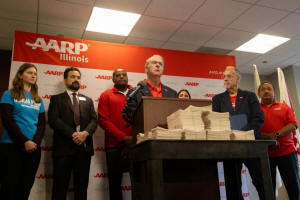Natural gas rate increases likely for Ameren, Nicor customers next year
[October 25, 2025]
By Andrew Adams
Customers across Illinois could face increased natural gas rates next
year, based on proposed decisions in two proceedings before the Illinois
Commerce Commission.
The regulatory agency, which oversees gas utilities, is considering two
requests from Nicor Gas and Ameren Illinois. A five-member panel of
commissioners, appointed by Gov. JB Pritzker, will make the final
decision in the cases in November.
But administrative judges overseeing the cases have released proposed
decisions which suggest cutting Nicor and Ameren’s requests by about one
third.
Nicor, which delivers natural gas to 2.3 million customers in northern
and western Illinois, asked for a $314 million rate increase in January
— equivalent to about $91.50 per year or a 9.21% increase for
residential customers, according to the company.
Ameren, which has 800,000 customers throughout downstate Illinois, asked
for a $129 million increase in January, or about $100 per year, or about
a 13% increase for residential customers, according to the Citizens
Utility Board, a consumer watchdog group.
The proposed decisions cut Nicor’s request by $109.8 million and
Ameren’s by about $43.7 million, according to CUB. Ameren officials said
the cuts bring the increase down to $5.80 per month, or about $70 per
year for the typical customer. Nicor officials said the increase under
the order would be about 5% to 6%.

“Even with the proposed increase, our distribution rates remain among
the lowest of any major natural gas utility in Illinois and the total
bill for an average residential customer under proposed rates continues
to remain in line with the Consumer Price Index,” Nicor spokesperson
Jennifer Golz said in a statement.
Brad Kloeppel, Ameren’s senior director of gas operations, defended his
company’s request for higher rates by saying the majority of the
increased revenue will go toward safety upgrades and compliance with
federally required safety testing.
“Fifty percent of the pipes on our system are over 50 years old,”
Kloeppel said. “We have to design, operate, maintain our system to
provide gas service on the coldest hour of the coldest day.”
Ameren’s rate case also includes pilot programs that could swap gas
service in some areas for electric service, and for an incentive program
for “renewable natural gas” — a method of capturing methane from
landfills and other sources that would otherwise be released as a
pollutant.
Despite proponents’ claims that it can help reduce greenhouse gas
emissions, some environmentalists criticize that technology for still
releasing some pollutants.
Advocates want more cuts
The gas cases have attracted significant attention from consumer
advocacy groups, who say the requests go too far and represent a trend
of increasingly frequent rate hikes.
[to top of second column]
|

Al Hollenbeck, AARP Illinois’ volunteer state president, speaks at
an Oct. 22 news conference alongside representatives from Illinois
PIRG and the Citizens Utility Board. (Capitol News Illinois photo by
Andrew Adams)

“This is part of a troubling trend being repeated, where large rate
hikes are becoming the norm, and consumers simply cannot keep paying the
price,” Jeff Scott, AARP’s senior associate state director, said in a
statement.
The most frequent target of utility criticism from consumer groups in
cases like these is the “return on equity” — a way of calculating the
profits returned to shareholders.
Nicor asked regulators for a bump from about 9.51% to 10.35%. Ameren’s
ask was similar, 9.44% to 10.7%. Most of the reductions recommended by
the administrative law judges stemmed from lowering both companies’
return on equity figures to 9.93%.
Most of the overall reduction to both rate increases comes from the
lower profit rates, with reductions also stemming from cuts to things
like post-employment benefits.
“The companies always claim this is about maintenance, but at the same
time they’re asking for an outrageous profit rate to their
shareholders,” CUB spokesperson Jim Chilsen said. “That exposes their
true motivation for their rate hike requests.”
Abe Scarr, director of the consumer advocacy group Illinois PIRG, said
there “really is a lot more work for the commission to do” beyond the
cuts to profit rates. He said that the commission’s decision is tied up
into the uncertain future of gas utilities in the state.
“Regardless of the future and exactly the pathway, there are going to be
fewer customers on the gas system using less gas,” Scarr said. “If the
utilities keep spending the way they’re doing, it’s going to make rates
even more unaffordable for more people.”
The ICC is weighing that question in a yearslong “Future of Gas”
proceeding in which advocates, utilities and businesses are advising
regulators what the natural gas industry will look like as the state
approaches its deadlines for reducing greenhouse gas emissions.
In the meantime, the deadline for the commission to act is Nov. 24 in
the Nicor case and Dec. 1 in the Ameren case.
Capitol News Illinois is
a nonprofit, nonpartisan news service that distributes state government
coverage to hundreds of news outlets statewide. It is funded primarily
by the Illinois Press Foundation and the Robert R. McCormick Foundation.
 |